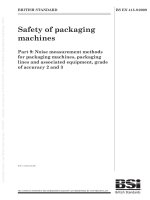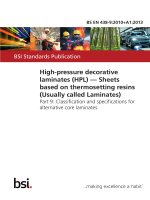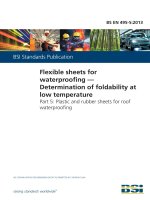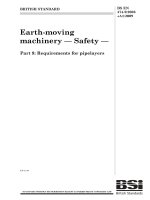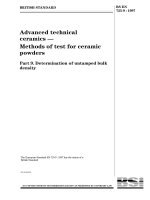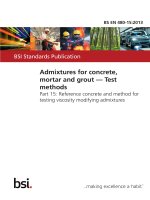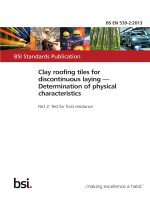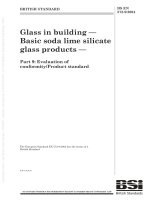Bsi bs en 61131 9 2013
Bạn đang xem bản rút gọn của tài liệu. Xem và tải ngay bản đầy đủ của tài liệu tại đây (3.85 MB, 264 trang )
BS EN 61131-9:2013
BSI Standards Publication
Programmable
controllers
Part 9: Single-drop digital
communication interface for small
sensors and actuators (SDCI)
BS EN 61131-9:2013 BRITISH STANDARD
National foreword
This British Standard is the UK implementation of EN 61131-9:2013. It is
identical to IEC 61131-9:2013.
The UK participation in its preparation was entrusted by Technical Com-
mittee GEL/65, Measurement and control, to Subcommittee GEL/65/2,
Elements of systems.
A list of organizations represented on this committee can be obtained on
request to its secretary.
This publication does not purport to include all the necessary provisions of
a contract. Users are responsible for its correct application.
© The British Standards Institution 2014.
Published by BSI Standards Limited 2014
ISBN 978 0 580 76607 7
ICS 25.040.40; 35.240.50
Compliance with a British Standard cannot confer immunity from
legal obligations.
This British Standard was published under the authority of the
Standards Policy and Strategy Committee on 28 February 2014.
Amendments/corrigenda issued since publication
Date Text affected
EUROPEAN STANDARD BS EN 61131-9:2013
NORME EUROPÉENNE
EUROPÄISCHE NORM EN 61131-9
ICS 25.040.40; 35.240.50 December 2013
English version
Programmable controllers -
Part 9: Single-drop digital communication interface for small sensors and
actuators (SDCI)
(IEC 61131-9:2013)
Automates programmables - Speicherprogrammierbare Steuerungen -
Partie 9: Interface de communication Teil 9: Schnittstelle für die Kommunikation
numérique point à point pour petits mit kleinen Sensoren und Aktoren über
capteurs et actionneurs (SDCI) eine Punkt-zu-Punkt-Verbindung
(CEI 61131-9:2013) (IEC 61131-9:2013)
This European Standard was approved by CENELEC on 2013-10-16. CENELEC members are bound to comply
with the CEN/CENELEC Internal Regulations which stipulate the conditions for giving this European Standard
the status of a national standard without any alteration.
Up-to-date lists and bibliographical references concerning such national standards may be obtained on
application to the CEN-CENELEC Management Centre or to any CENELEC member.
This European Standard exists in three official versions (English, French, German). A version in any other
language made by translation under the responsibility of a CENELEC member into its own language and notified
to the CEN-CENELEC Management Centre has the same status as the official versions.
CENELEC members are the national electrotechnical committees of Austria, Belgium, Bulgaria, Croatia, Cyprus,
the Czech Republic, Denmark, Estonia, Finland, Former Yugoslav Republic of Macedonia, France, Germany,
Greece, Hungary, Iceland, Ireland, Italy, Latvia, Lithuania, Luxembourg, Malta, the Netherlands, Norway, Poland,
Portugal, Romania, Slovakia, Slovenia, Spain, Sweden, Switzerland, Turkey and the United Kingdom.
CENELEC European Committee for Electrotechnical Standardization
Comité Européen de Normalisation Electrotechnique
Europäisches Komitee für Elektrotechnische Normung
CEN-CENELEC Management Centre: Avenue Marnix 17, B - 1000 Brussels
© 2013 CENELEC - All rights of exploitation in any form and by any means reserved worldwide for CENELEC members.
Ref. No. EN 61131-9:2013 E
BS EN 61131-9:2013
EN 61131-9:2013 - 2 -
Foreword
The text of document 65B/874/FDIS, future edition 1 of IEC 61131-9, prepared by SC 65B, "Measurement
and control devices", of IEC/TC 65, "Industrial-process measurement, control and automation" was
submitted to the IEC-CENELEC parallel vote and approved by CENELEC as EN 61131-9:2013.
The following dates are fixed: (dop) 2014-07-16
(dow) 2016-10-16
• latest date by which the document has
to be implemented at national level by
publication of an identical national
standard or by endorsement
• latest date by which the national
standards conflicting with the
document have to be withdrawn
Attention is drawn to the possibility that some of the elements of this document may be the subject of
patent rights. CENELEC [and/or CEN] shall not be held responsible for identifying any or all such patent
rights.
Endorsement notice
The text of the International Standard IEC 61131-9:2013 was approved by CENELEC as a European
Standard without any modification.
In the official version, for Bibliography, the following notes have to be added for the standards indicated:
IEC 60870-5-1:1990 NOTE Harmonised as EN 60870-5-1:1993 (not modified).
IEC 61158-2 NOTE Harmonised as EN 61158-2 (not modified).
IEC/TR 62453-61 NOTE Harmonised as CLC/TR 62453-61 (not modified).
ISOIEC 7498-1 NOTE Harmonised as EN ISOIEC 7498-1 (not modified).
BS EN 61131-9:2013
- 3 - EN 61131-9:2013
Annex ZA
(normative)
Normative references to international publications
with their corresponding European publications
The following referenced documents are indispensable for the application of this document. For dated
references, only the edition cited applies. For undated references, the latest edition of the referenced
document (including any amendments) applies.
NOTE When an international publication has been modified by common modifications, indicated by (mod), the relevant EN/HD
applies.
Publication Year Title EN/HD Year
IEC 60947-5-2 - -
IEC 61000-4-2 Low-voltage switchgear and controlgear - EN 60947-5-2
IEC 61000-4-3 - Part 5-2: Control circuit devices and -
IEC 61000-4-4 - switching elements - Proximity switches
IEC 61000-4-5 - -
IEC 61000-4-6 - Electromagnetic compatibility (EMC) - EN 61000-4-2
- -
IEC 61000-4-11 Part 4-2: Testing and measurement
IEC 61000-6-2 - -
IEC 61000-6-4 - techniques - Electrostatic discharge immunity -
IEC 61076-2-101 -
- test -
IEC 61131-1
- Electromagnetic compatibility (EMC) - EN 61000-4-3 -
Part 4-3: Testing and measurement -
techniques - Radiated, radio-frequency, -
electromagnetic field immunity test -
Electromagnetic compatibility (EMC) - EN 61000-4-4 -
Part 4-4: Testing and measurement
techniques - Electrical fast transient/burst
immunity test
Electromagnetic compatibility (EMC) - FprEN 61000-4-5
Part 4-5: Testing and measurement
techniques - Surge immunity test
Electromagnetic compatibility (EMC) - FprEN 61000-4-6
Part 4-6: Testing and measurement
techniques - Immunity to conducted
disturbances, induced by radio-frequency
fields
Electromagnetic compatibility (EMC) - EN 61000-4-11
Part 4-11: Testing and measurement
techniques - Voltage dips, short interruptions
and voltage variations immunity tests
Electromagnetic compatibility (EMC) - EN 61000-6-2
Part 6-2: Generic standards - Immunity for + corr. September
industrial environments
Electromagnetic compatibility (EMC) - EN 61000-6-4
Part 6-4: Generic standards - Emission
standard for industrial environments
Connectors for electronic equipment - EN 61076-2-101
Product requirements -
Part 2-101: Circular connectors - Detail
specification for M12 connectors with
screw-locking
Programmable controllers - EN 61131-1
Part 1: General information
BS EN 61131-9:2013
EN 61131-9:2013 - 4 -
Publication Year Title EN/HD Year
IEC 61131-2 - Programmable controllers - EN 61131-21) -
IEC/TR 62390 - Part 2: Equipment requirements and tests -
ISO/IEC 646 -
ISO/IEC 2022 1991 Common automation device - Profile guideline - -
ISO/IEC 10646 - -
ISO/IEC 10731 - Information technology - ISO 7-bit coded - -
-
ISO 1177 character set for information interchange -
-
IEEE 754 Information technology - Character code - -
2008
structure and extension techniques
Information technology - Universal Coded -
Character Set (UCS)
Information technology - Open Systems -
Interconnection - Basic reference model -
Conventions for the definition of OSI services
Information processing - Character structure for -
start/stop and synchronous character-oriented
transmission
Binary floating-point arithmetic -
1) EN 61131-2 is superseded by EN 61010-2-201:2013, which is based on IEC 61010-2-201:2013.
– 2 – BS EN 61131-9:2013
61131-9 © IEC:2013
CONTENTS
INTRODUCTION................................................................................................................... 16
1 Scope............................................................................................................................. 18
2 Normative references ..................................................................................................... 18
3 Terms, definitions, symbols, abbreviated terms and conventions .................................... 19
3.1 Terms and definitions ............................................................................................ 19
3.2 Symbols and abbreviated terms............................................................................. 23
3.3 Conventions .......................................................................................................... 25
3.3.1 General ..................................................................................................... 25
3.3.2 Service parameters ................................................................................... 25
3.3.3 Service procedures.................................................................................... 26
3.3.4 Service attributes ...................................................................................... 26
3.3.5 Figures ...................................................................................................... 26
3.3.6 Transmission octet order ........................................................................... 26
3.3.7 Behavioral descriptions ............................................................................. 27
4 Overview of SDCI (IO-LinkTM) ......................................................................................... 27
4.1 Purpose of technology........................................................................................... 27
4.2 Positioning within the automation hierarchy ........................................................... 28
4.3 Wiring, connectors and power ............................................................................... 29
4.4 Communication features of SDCI........................................................................... 29
4.5 Role of a Master .................................................................................................... 31
4.6 SDCI configuration ................................................................................................ 32
4.7 Mapping to fieldbuses ........................................................................................... 32
4.8 Standard structure................................................................................................. 32
5 Physical Layer (PL) ........................................................................................................ 33
5.1 General ................................................................................................................. 33
5.1.1 Basics ....................................................................................................... 33
5.1.2 Topology ................................................................................................... 33
5.2 Physical layer services .......................................................................................... 34
5.2.1 Overview ................................................................................................... 34
5.2.2 PL services................................................................................................ 35
5.3 Transmitter/Receiver ............................................................................................. 37
5.3.1 Description method.................................................................................... 37
5.3.2 Electrical requirements .............................................................................. 37
5.3.3 Timing requirements .................................................................................. 41
5.4 Power supply......................................................................................................... 44
5.4.1 Power supply options ................................................................................ 44
5.4.2 Power-on requirements.............................................................................. 45
5.5 Medium ................................................................................................................. 45
5.5.1 Connectors ................................................................................................ 45
5.5.2 Cable......................................................................................................... 47
6 Standard Input and Output (SIO) .................................................................................... 48
7 Data link layer (DL) ........................................................................................................ 48
7.1 General ................................................................................................................. 48
7.2 Data link layer services ......................................................................................... 50
7.2.1 DL-B services ............................................................................................ 50
BS EN 61131-9:2013 – 3 –
61131-9 © IEC:2013
7.2.2 DL-A services ............................................................................................ 61
7.3 Data link layer protocol.......................................................................................... 66
7.3.1 Overview ................................................................................................... 66
7.3.2 DL-mode handler ....................................................................................... 67
7.3.3 Message handler ....................................................................................... 75
7.3.4 Process Data handler ................................................................................ 82
7.3.5 On-request Data handler ........................................................................... 85
7.3.6 ISDU handler ............................................................................................. 88
7.3.7 Command handler ..................................................................................... 92
7.3.8 Event handler ............................................................................................ 95
8 Application layer (AL) ..................................................................................................... 98
8.1 General ................................................................................................................. 98
8.2 Application layer services ...................................................................................... 99
8.2.1 AL services within Master and Device........................................................ 99
8.2.2 AL Services ............................................................................................. 100
8.3 Application layer protocol .................................................................................... 108
8.3.1 Overview ................................................................................................. 108
8.3.2 On-request Data transfer ......................................................................... 108
8.3.3 Event processing ..................................................................................... 114
8.3.4 Process Data cycles ................................................................................ 117
9 System management (SM) ........................................................................................... 118
9.1 General ............................................................................................................... 118
9.2 System management of the Master ..................................................................... 118
9.2.1 Overview ................................................................................................. 118
9.2.2 SM Master services ................................................................................. 120
9.2.3 SM Master protocol ................................................................................. 125
9.3 System management of the Device ..................................................................... 133
9.3.1 Overview ................................................................................................. 133
9.3.2 SM Device services ................................................................................. 135
9.3.3 SM Device protocol ................................................................................. 141
10 Device .......................................................................................................................... 148
10.1 Overview ............................................................................................................. 148
10.2 Process Data Exchange (PDE) ............................................................................ 149
10.3 Parameter Manager (PM) .................................................................................... 149
10.3.1 General ................................................................................................... 149
10.3.2 Parameter manager state machine .......................................................... 149
10.3.3 Dynamic parameter ................................................................................. 151
10.3.4 Single parameter ..................................................................................... 152
10.3.5 Block parameter ...................................................................................... 153
10.3.6 Concurrent parameterization access........................................................ 155
10.3.7 Command handling.................................................................................. 155
10.4 Data Storage (DS) ............................................................................................... 155
10.4.1 General ................................................................................................... 155
10.4.2 Data Storage state machine .................................................................... 155
10.4.3 DS configuration ...................................................................................... 157
10.4.4 DS memory space ................................................................................... 157
10.4.5 DS Index_List .......................................................................................... 158
10.4.6 DS parameter availability......................................................................... 158
10.4.7 DS without ISDU...................................................................................... 158
– 4 – BS EN 61131-9:2013
61131-9 © IEC:2013
10.4.8 DS parameter change indication .............................................................. 158
10.5 Event Dispatcher (ED) ......................................................................................... 158
10.6 Device features ................................................................................................... 158
10.6.1 General ................................................................................................... 158
10.6.2 Device backward compatibility ................................................................. 159
10.6.3 Protocol revision compatibility ................................................................. 159
10.6.4 Factory settings ....................................................................................... 159
10.6.5 Application reset...................................................................................... 159
10.6.6 Device reset ............................................................................................ 159
10.6.7 Visual SDCI indication ............................................................................. 159
10.6.8 Parameter access locking........................................................................ 160
10.6.9 Data Storage locking ............................................................................... 160
10.6.10Device parameter locking ........................................................................ 160
10.6.11Device user interface locking ................................................................... 160
10.6.12Offset time............................................................................................... 160
10.6.13Data Storage concept .............................................................................. 161
10.6.14Block Parameter ...................................................................................... 161
10.7 Device design rules and constraints .................................................................... 161
10.7.1 General ................................................................................................... 161
10.7.2 Process Data........................................................................................... 161
10.7.3 Communication loss ................................................................................ 161
10.7.4 Direct Parameter ..................................................................................... 161
10.7.5 ISDU communication channel .................................................................. 162
10.7.6 DeviceID rules related to Device variants ................................................ 162
10.7.7 Protocol constants ................................................................................... 162
10.8 IO Device description (IODD) .............................................................................. 163
10.9 Device diagnosis ................................................................................................. 163
10.9.1 Concepts ................................................................................................. 163
10.9.2 Events ..................................................................................................... 164
10.9.3 Visual indicators ...................................................................................... 165
10.10 Device connectivity ............................................................................................. 166
11 Master .......................................................................................................................... 166
11.1 Overview ............................................................................................................. 166
11.2 11.1.1 Generic model for the system integration of a Master .............................. 166
11.1.2 Structure and services of a Master .......................................................... 166
11.3 Configuration Manager (CM) ............................................................................... 169
11.2.1 General ................................................................................................... 169
11.4 11.2.2 Configuration parameter .......................................................................... 171
11.5 11.2.3 State machine of the Configuration Manager ........................................... 173
11.6 Data Storage (DS) ............................................................................................... 175
11.3.1 Overview ................................................................................................. 175
11.3.2 DS data object......................................................................................... 175
11.3.3 DS state machine .................................................................................... 175
11.3.4 Parameter selection for Data Storage ...................................................... 181
On-Request Data exchange (ODE) ...................................................................... 181
Diagnosis Unit (DU)............................................................................................. 182
PD Exchange (PDE) ............................................................................................ 183
11.6.1 General ................................................................................................... 183
11.6.2 Process Data mapping............................................................................. 183
BS EN 61131-9:2013 – 5 –
61131-9 © IEC:2013
11.6.3 Process Data invalid/valid qualifier status ................................................ 184
11.7 Port and Device configuration tool (PDCT) .......................................................... 185
11.7.1 General ................................................................................................... 185
11.7.2 Basic layout examples ............................................................................. 185
11.8 Gateway application ............................................................................................ 186
11.8.1 General ................................................................................................... 186
11.8.2 Changing Device configuration including Data Storage ............................ 186
11.8.3 Parameter server and recipe control ........................................................ 186
11.8.4 Anonymous parameters ........................................................................... 186
11.8.5 Virtual port mode DIwithSDCI .................................................................. 187
Annex A (normative) Codings, timing constraints, and errors ............................................. 190
Annex B (normative) Parameter and commands ................................................................ 211
Annex C (normative) ErrorTypes (ISDU errors) .................................................................. 228
Annex D (normative) EventCodes (diagnosis information) .................................................. 233
Annex E (normative) Data types ........................................................................................ 236
Annex F (normative) Structure of the Data Storage data object.......................................... 247
Annex G (normative) Master and Device conformity........................................................... 248
Annex H (informative) Residual error probabilities ............................................................. 254
Annex I (informative) Example sequence of an ISDU transmission..................................... 256
Annex J (informative) Recommended methods for detecting parameter changes ............... 258
Bibliography........................................................................................................................ 259
Figure 1 – Example of a confirmed service ........................................................................... 26
Figure 2 – Memory storage and transmission order for WORD based data types ..................27
Figure 3 – SDCI compatibility with IEC 61131-2 .................................................................... 27
Figure 4 – Domain of the SDCI technology within the automation hierarchy ..........................28
Figure 5 – Generic Device model for SDCI (Master's view) ................................................... 29
Figure 6 – Relationship between nature of data and transmission types................................ 30
Figure 7 – Object transfer at the application layer level (AL) ................................................. 31
Figure 8 – Logical structure of Master and Device................................................................. 32
Figure 9 – Three wire connection system .............................................................................. 33
Figure 10 – Topology of SDCI ............................................................................................... 34
Figure 11 – Physical layer (Master)....................................................................................... 34
Figure 12 – Physical layer (Device)....................................................................................... 35
Figure 13 – Line driver reference schematics........................................................................ 37
Figure 14 – Receiver reference schematics .......................................................................... 37
Figure 15 – Reference schematics for SDCI 3-wire connection system ................................. 38
Figure 16 – Voltage level definitions ..................................................................................... 38
Figure 17 – Switching thresholds .......................................................................................... 39
Figure 18 – Format of an SDCI UART frame ......................................................................... 41
Figure 19 – Eye diagram for the 'H' and 'L' detection ............................................................ 42
Figure 20 – Eye diagram for the correct detection of a UART frame ...................................... 42
Figure 21 – Wake-up request ................................................................................................ 44
Figure 22 – Power-on timing for Power1 ............................................................................... 45
– 6 – BS EN 61131-9:2013
61131-9 © IEC:2013
Figure 23 – Pin layout front view ........................................................................................... 46
Figure 24 – Class A and B port definitions ............................................................................ 47
Figure 25 – Reference schematic for effective line capacitance and loop resistance .............47
Figure 26 – Structure and services of the data link layer (Master) ......................................... 49
Figure 27 – Structure and services of the data link layer (Device) ......................................... 49
Figure 28 – State machines of the data link layer .................................................................. 67
Figure 29 – Example of an attempt to establish communication ............................................ 67
Figure 30 – Failed attempt to establish communication ......................................................... 68
Figure 31 – Retry strategy to establish communication ......................................................... 68
Figure 32 – Fallback procedure............................................................................................. 69
Figure 33 – State machine of the Master DL-mode handler ................................................... 70
Figure 34 – Submachine 1 to establish communication ......................................................... 71
Figure 35 – State machine of the Device DL-mode handler ................................................... 73
Figure 36 – SDCI message sequences ................................................................................. 75
Figure 37 – Overview of M-sequence types........................................................................... 76
Figure 38 – State machine of the Master message handler ................................................... 77
Figure 39 – Submachine "Response 3" of the message handler ............................................ 78
Figure 40 – Submachine "Response 8" of the message handler ............................................ 78
Figure 41 – Submachine "Response 15" of the message handler .......................................... 78
Figure 42 – State machine of the Device message handler ................................................... 81
Figure 43 – Interleave mode for the segmented transmission of Process Data ......................83
Figure 44 – State machine of the Master Process Data handler ............................................ 83
Figure 45 – State machine of the Device Process Data handler ............................................ 85
Figure 46 – State machine of the Master On-request Data handler .......................................86
Figure 47 – State machine of the Device On-request Data handler .......................................87
Figure 48 – Structure of the ISDU ......................................................................................... 88
Figure 49 – State machine of the Master ISDU handler ......................................................... 90
Figure 50 – State machine of the Device ISDU handler ......................................................... 91
Figure 51 – State machine of the Master command handler .................................................. 93
Figure 52 – State machine of the Device command handler .................................................. 94
Figure 53 – State machine of the Master Event handler ........................................................ 96
Figure 54 – State machine of the Device Event handler ........................................................ 97
Figure 55 – Structure and services of the application layer (Master) ..................................... 98
Figure 56 – Structure and services of the application layer (Device) ..................................... 99
Figure 57 – OD state machine of the Master AL .................................................................. 109
Figure 58 – OD state machine of the Device AL .................................................................. 110
Figure 59 – Sequence diagram for the transmission of On-request Data ............................. 112
Figure 60 – Sequence diagram for On-request Data in case of errors ................................. 113
Figure 61 – Sequence diagram for On-request Data in case of timeout ............................... 113
Figure 62 – Event state machine of the Master AL .............................................................. 114
Figure 63 – Event state machine of the Device AL .............................................................. 115
Figure 64 – Single Event scheduling ................................................................................... 116
Figure 65 – Sequence diagram for output Process Data...................................................... 117
BS EN 61131-9:2013 – 7 –
61131-9 © IEC:2013
Figure 66 – Sequence diagram for input Process Data........................................................ 118
Figure 67 – Structure and services of the Master system management ............................... 119
Figure 68 – Sequence chart of the use case "port x setup" ................................................. 120
Figure 69 – Main state machine of the Master system management.................................... 126
Figure 70 – SM Master submachine CheckCompatibility_1 ................................................. 128
Figure 71 – Activity for state "CheckVxy" ............................................................................ 130
Figure 72 – Activity for state "CheckCompV10" ................................................................... 130
Figure 73 – Activity for state "CheckComp" ......................................................................... 131
Figure 74 – Activity (write parameter) in state "RestartDevice"............................................ 131
Figure 75 – SM Master submachine CheckSerNum_3 ......................................................... 132
Figure 76 – Activity (check SerialNumber) for state CheckSerNum_3.................................. 133
Figure 77 – Structure and services of the system management (Device) ............................. 134
Figure 78 – Sequence chart of the use case "INACTIVE – SIO – SDCI – SIO" .................... 135
Figure 79 – State machine of the Device system management............................................ 142
Figure 80 – Sequence chart of a regular Device startup ...................................................... 145
Figure 81 – Sequence chart of a Device startup in compatibility mode ................................ 146
Figure 82 – Sequence chart of a Device startup when compatibility fails ............................. 147
Figure 83 – Structure and services of a Device ................................................................... 148
Figure 84 – The Parameter Manager (PM) state machine ................................................... 150
Figure 85 – Positive and negative parameter checking result .............................................. 152
Figure 86 – Positive block parameter download with Data Storage request ......................... 153
Figure 87 – Negative block parameter download ................................................................. 154
Figure 88 – The Data Storage (DS) state machine .............................................................. 156
Figure 89 – Data Storage request message sequence ........................................................ 157
Figure 90 – Cycle timing ..................................................................................................... 160
Figure 91 – Event flow in case of successive errors ............................................................ 165
Figure 92 – Device LED indicator timing ............................................................................. 165
Figure 93 – Generic relationship of SDCI technology and fieldbus technology .................... 166
Figure 94 – Structure and services of a Master ................................................................... 168
Figure 95 – Relationship of the common Master applications .............................................. 168
Figure 96 – Sequence diagram of configuration manager actions........................................ 170
Figure 97 – Ports in MessageSync mode ............................................................................ 171
Figure 98 – State machine of the Configuration Manager .................................................... 173
Figure 99 – Main state machine of the Data Storage mechanism ........................................ 175
Figure 100 – Submachine "UpDownload_2" of the Data Storage mechanism ...................... 176
Figure 101 – Data Storage submachine "Upload_7" ............................................................ 177
Figure 102 – Data Storage upload sequence diagram ......................................................... 177
Figure 103 – Data Storage submachine "Download_10"...................................................... 178
Figure 104 – Data Storage download sequence diagram..................................................... 178
Figure 105 – State machine of the On-request Data Exchange ........................................... 181
Figure 106 – System overview of SDCI diagnosis information propagation via Events ........ 183
Figure 107 – Process Data mapping from ports to the gateway data stream........................ 184
Figure 108 – Propagation of PD qualifier status between Master and Device ...................... 184
– 8 – BS EN 61131-9:2013
61131-9 © IEC:2013
Figure 109 – Example 1 of a PDCT display layout............................................................... 185
Figure 110 – Example 2 of a PDCT display layout............................................................... 186
Figure 111 – Alternative Device configuration ..................................................................... 187
Figure 112 – Virtual port mode "DIwithSDCI" ...................................................................... 188
Figure A.1 – M-sequence control ........................................................................................ 190
Figure A.2 – Checksum/M-sequence type octet .................................................................. 191
Figure A.3 – Checksum/status octet.................................................................................... 192
Figure A.4 – Principle of the checksum calculation and compression .................................. 193
Figure A.5 – M-sequence TYPE_0 ...................................................................................... 194
Figure A.6 – M-sequence TYPE_1_1 .................................................................................. 194
Figure A.7 – M-sequence TYPE_1_2 .................................................................................. 195
Figure A.8 – M-sequence TYPE_1_V .................................................................................. 195
Figure A.9 – M-sequence TYPE_2_1 .................................................................................. 196
Figure A.10 – M-sequence TYPE_2_2 ................................................................................ 196
Figure A.11 – M-sequence TYPE_2_3 ................................................................................ 196
Figure A.12 – M-sequence TYPE_2_4 ................................................................................ 197
Figure A.13 – M-sequence TYPE_2_5 ................................................................................ 197
Figure A.14 – M-sequence TYPE_2_6 ................................................................................ 197
Figure A.15 – M-sequence TYPE_2_V ................................................................................ 198
Figure A.16 – M-sequence timing........................................................................................ 201
Figure A.17 – I-Service octet .............................................................................................. 203
Figure A.18 – Check of ISDU integrity via CHKPDU............................................................ 205
Figure A.19 – Examples of request formats for ISDUs......................................................... 206
Figure A.20 – Examples of response ISDUs........................................................................ 206
Figure A.21 – Examples of read and write request ISDUs ................................................... 207
Figure A.22 – Structure of StatusCode type 1 ..................................................................... 208
Figure A.23 – Structure of StatusCode type 2 ..................................................................... 208
Figure A.24 – Indication of activated Events ....................................................................... 209
Figure A.25 – Structure of the EventQualifier ...................................................................... 209
Figure B.1 – Classification and mapping of Direct Parameters ............................................ 211
Figure B.2 – MinCycleTime ................................................................................................. 213
Figure B.3 – M-sequence Capability ................................................................................... 214
Figure B.4 – RevisionID ...................................................................................................... 215
Figure B.5 – ProcessDataIn ................................................................................................ 215
Figure B.6 – Index space for ISDU data objects .................................................................. 217
Figure B.7 – Structure of the Offset Time ............................................................................ 226
Figure E.1 – Coding examples of UIntegerT ........................................................................ 237
Figure E.2 – Coding examples of IntegerT .......................................................................... 239
Figure E.3 – Singular access of StringT .............................................................................. 240
Figure E.4 – Coding example of OctetStringT ..................................................................... 241
Figure E.5 – Definition of TimeT ......................................................................................... 241
Figure E.6 – Example of an ArrayT data structure ............................................................... 243
Figure E.7 – Example 2 of a RecordT structure................................................................... 245
BS EN 61131-9:2013 – 9 –
61131-9 © IEC:2013
Figure E.8 – Example 3 of a RecordT structure................................................................... 245
Figure E.9 – Write requests for example 3 .......................................................................... 246
Figure G.1 – Test setup for electrostatic discharge (Master) ............................................... 250
Figure G.2 – Test setup for RF electromagnetic field (Master) ............................................ 250
Figure G.3 – Test setup for fast transients (Master) ............................................................ 251
Figure G.4 – Test setup for RF common mode (Master) ...................................................... 251
Figure G.5 – Test setup for electrostatic discharges (Device) ............................................. 252
Figure G.6 – Test setup for RF electromagnetic field (Device) ............................................ 252
Figure G.7 – Test setup for fast transients (Device) ............................................................ 252
Figure G.8 – Test setup for RF common mode (Device) ...................................................... 253
Figure H.1 – Residual error probability for the SDCI data integrity mechanism.................... 254
Figure I.1 – Example for ISDU transmissions (1 of 2) .......................................................... 256
Table 1 – Service assignments of Master and Device ........................................................... 35
Table 2 – PL_SetMode ......................................................................................................... 35
Table 3 – PL_WakeUp .......................................................................................................... 36
Table 4 – PL_Transfer .......................................................................................................... 36
Table 5 – Electric characteristics of a receiver ...................................................................... 39
Table 6 – Electric characteristics of a Master port ................................................................. 39
Table 7 – Electric characteristics of a Device ........................................................................ 40
Table 8 – Dynamic characteristics of the transmission .......................................................... 43
Table 9 – Wake-up request characteristics ........................................................................... 44
Table 10 – Power-on timing .................................................................................................. 45
Table 11 – Pin assignments .................................................................................................. 46
Table 12 – Cable characteristics ........................................................................................... 47
Table 13 – Cable conductor assignments.............................................................................. 48
Table 14 – Service assignments within Master and Device ................................................... 50
Table 15 – DL_ReadParam ................................................................................................... 51
Table 16 – DL_WriteParam ................................................................................................... 51
Table 17 – DL_Read ............................................................................................................. 52
Table 18 – DL_Write ............................................................................................................. 53
Table 19 – DL_ISDUTransport .............................................................................................. 54
Table 20 – DL_ISDUAbort..................................................................................................... 55
Table 21 – DL_PDOutputUpdate ........................................................................................... 55
Table 22 – DL_PDOutputTransport ....................................................................................... 56
Table 23 – DL_PDInputUpdate ............................................................................................. 57
Table 24 – DL_PDInputTransport .......................................................................................... 57
Table 25 – DL_PDCycle........................................................................................................ 58
Table 26 – DL_SetMode ....................................................................................................... 58
Table 27 – DL_Mode............................................................................................................. 59
Table 28 – DL_Event ............................................................................................................ 60
Table 29 – DL_EventConf ..................................................................................................... 60
Table 30 – DL_EventTrigger ................................................................................................. 61
– 10 – BS EN 61131-9:2013
61131-9 © IEC:2013
Table 31 – DL_Control .......................................................................................................... 61
Table 32 – DL-A services within Master and Device .............................................................. 62
Table 33 – OD ...................................................................................................................... 62
Table 34 – PD....................................................................................................................... 63
Table 35 – EventFlag............................................................................................................ 64
Table 36 – PDInStatus .......................................................................................................... 65
Table 37 – MHInfo ................................................................................................................ 65
Table 38 – ODTrig ................................................................................................................ 66
Table 39 – PDTrig................................................................................................................. 66
Table 40 – Wake-up procedure and retry characteristics ....................................................... 69
Table 41 – Fallback timing characteristics............................................................................. 70
Table 42 – State transition tables of the Master DL-mode handler ........................................71
Table 43 – State transition tables of the Device DL-mode handler ........................................74
Table 44 – State transition table of the Master message handler .......................................... 79
Table 45 – State transition tables of the Device message handler.........................................82
Table 46 – State transition tables of the Master Process Data handler .................................. 84
Table 47 – State transition tables of the Device Process Data handler .................................. 85
Table 48 – State transition tables of the Master On-request Data handler .............................86
Table 49 – State transition tables of the Device On-request Data handler .............................88
Table 50 – FlowCTRL definitions .......................................................................................... 89
Table 51 – State transition tables of the Master ISDU handler .............................................. 90
Table 52 – State transition tables of the Device ISDU handler .............................................. 92
Table 53 – Control codes ...................................................................................................... 93
Table 54 – State transition tables of the Master command handler........................................93
Table 55 – State transition tables of the Device command handler........................................94
Table 56 – Event memory ..................................................................................................... 95
Table 57 – State transition tables of the Master Event handler .............................................. 96
Table 58 – State transition tables of the Device Event handler .............................................. 97
Table 59 – AL services within Master and Device ................................................................. 99
Table 60 – AL_Read ........................................................................................................... 100
Table 61 – AL_Write ........................................................................................................... 101
Table 62 – AL_Abort ........................................................................................................... 102
Table 63 – AL_GetInput ...................................................................................................... 102
Table 64 – AL_NewInput..................................................................................................... 103
Table 65 – AL_SetInput ...................................................................................................... 104
Table 66 – AL_PDCycle ...................................................................................................... 104
Table 67 – AL_GetOutput ................................................................................................... 105
Table 68 – AL_NewOutput .................................................................................................. 105
Table 69 – AL_SetOutput.................................................................................................... 106
Table 70 – AL_Event .......................................................................................................... 107
Table 71 – AL_Control ........................................................................................................ 108
Table 72 – States and transitions for the OD state machine of the Master AL ..................... 109
Table 73 – States and transitions for the OD state machine of the Device AL ..................... 111
BS EN 61131-9:2013 – 11 –
61131-9 © IEC:2013
Table 74 – State and transitions of the Event state machine of the Master AL..................... 114
Table 75 – State and transitions of the Event state machine of the Device AL..................... 115
Table 76 – SM services within the Master ........................................................................... 121
Table 77 – SM_SetPortConfig............................................................................................. 121
Table 78 – Definition of the InspectionLevel (IL) ................................................................. 122
Table 79 – Definitions of the Target Modes ......................................................................... 123
Table 80 – SM_GetPortConfig ............................................................................................ 123
Table 81 – SM_PortMode ................................................................................................... 124
Table 82 – SM_Operate ...................................................................................................... 125
Table 83 – State transition tables of the Master system management ................................. 127
Table 84 – State transition tables of the Master submachine CheckCompatibility_1 ............ 128
Table 85 – State transition tables of the Master submachine CheckSerNum_3.................... 132
Table 86 – SM services within the Device ........................................................................... 136
Table 87 – SM_SetDeviceCom ........................................................................................... 136
Table 88 – SM_GetDeviceCom ........................................................................................... 137
Table 89 – SM_SetDeviceIdent ........................................................................................... 138
Table 90 – SM_GetDeviceIdent .......................................................................................... 139
Table 91 – SM_SetDeviceMode .......................................................................................... 140
Table 92 – SM_DeviceMode ............................................................................................... 141
Table 93 – State transition tables of the Device system management ................................. 142
Table 94 – State transition tables of the PM state machine ................................................. 150
Table 95 – Definitions of parameter checks ........................................................................ 152
Table 96 – State transition table of the Data Storage state machine ................................... 156
Table 97 – Overview of the protocol constants for Devices ................................................. 162
Table 98 – Classification of Device diagnosis incidents....................................................... 164
Table 99 – Timing for LED indicators .................................................................................. 165
Table 100 – Internal variables and Events to control the common Master applications ........ 169
Table 101 – State transition tables of the Configuration Manager........................................ 174
Table 102 – States and transitions of the Data Storage state machines .............................. 179
Table 103 – State transition table of the ODE state machine............................................... 181
Table 104 – State transitions of the state machine "DIwithSDCI" ........................................ 188
Table A.1 – Values of communication channel .................................................................... 190
Table A.2 – Values of R/W .................................................................................................. 191
Table A.3 – Values of M-sequence types ............................................................................ 191
Table A.4 – Data types for user data................................................................................... 192
Table A.5 – Values of PD status ......................................................................................... 192
Table A.6 – Values of the Event flag ................................................................................... 193
Table A.7 – M-sequence types for the STARTUP mode ...................................................... 198
Table A.8 – M-sequence types for the PREOPERATE mode ............................................... 198
Table A.9 – M-sequence types for the OPERATE mode (legacy protocol) ........................... 199
Table A.10 – M-sequence types for the OPERATE mode .................................................... 199
Table A.11 – Recommended MinCycleTimes ...................................................................... 201
Table A.12 – Definition of the nibble "I-Service" .................................................................. 203
– 12 – BS EN 61131-9:2013
61131-9 © IEC:2013
Table A.13 – ISDU syntax ................................................................................................... 204
Table A.14 – Definition of nibble Length and octet ExtLength.............................................. 204
Table A.15 – Use of Index formats ...................................................................................... 205
Table A.16 – Mapping of EventCodes (type 1) .................................................................... 208
Table A.17 – Values of INSTANCE ..................................................................................... 209
Table A.18 – Values of SOURCE ........................................................................................ 210
Table A.19 – Values of TYPE.............................................................................................. 210
Table A.20 – Values of MODE ............................................................................................ 210
Table B.1 – Direct Parameter page 1 and 2 ........................................................................ 212
Table B.2 – Types of MasterCommands.............................................................................. 213
Table B.3 – Possible values of MasterCycleTime and MinCycleTime .................................. 214
Table B.4 – Values of ISDU ................................................................................................ 214
Table B.5 – Values of SIO................................................................................................... 215
Table B.6 – Permitted combinations of BYTE and Length ................................................... 215
Table B.7 – Implementation rules for parameters and commands........................................ 217
Table B.8 – Index assignment of data objects (Device parameter) ...................................... 218
Table B.9 – Coding of SystemCommand (ISDU) ................................................................. 219
Table B.10 – Data Storage Index assignments.................................................................... 220
Table B.11 – Structure of Index_List ................................................................................... 221
Table B.12 – Device locking possibilities............................................................................. 222
Table B.13 – Device status parameter ................................................................................ 224
Table B.14 – Detailed Device Status (Index 0x0025)........................................................... 225
Table B.15 – Time base coding and values of Offset Time .................................................. 226
Table C.1 – ErrorTypes....................................................................................................... 228
Table C.2 – Derived ErrorTypes.......................................................................................... 231
Table D.1 – EventCodes ..................................................................................................... 233
Table D.2 – Basic SDCI EventCodes .................................................................................. 235
Table E.1 – BooleanT ......................................................................................................... 236
Table E.2 – BooleanT coding .............................................................................................. 236
Table E.3 – UIntegerT......................................................................................................... 237
Table E.4 – IntegerT ........................................................................................................... 237
Table E.5 – IntegerT coding (8 octets) ................................................................................ 238
Table E.6 – IntegerT coding (4 octets) ................................................................................ 238
Table E.7 – IntegerT coding (2 octets) ................................................................................ 238
Table E.8 – IntegerT coding (1 octet) .................................................................................. 238
Table E.9 – Float32T .......................................................................................................... 239
Table E.10 – Coding of Float32T ........................................................................................ 239
Table E.11 – StringT ........................................................................................................... 240
Table E.12 – OctetStringT................................................................................................... 240
Table E.13 – TimeT ............................................................................................................ 241
Table E.14 – Coding of TimeT ............................................................................................ 242
Table E.15 – TimeSpanT .................................................................................................... 242
Table E.16 – Coding of TimeSpanT .................................................................................... 242
BS EN 61131-9:2013 – 13 –
61131-9 © IEC:2013
Table E.17 – Structuring rules for ArrayT ............................................................................ 243
Table E.18 – Example for the access of an ArrayT .............................................................. 243
Table E.19 – Structuring rules for RecordT ......................................................................... 244
Table E.20 – Example 1 for the access of a RecordT .......................................................... 244
Table E.21 – Example 2 for the access of a RecordT .......................................................... 244
Table E.22 – Example 3 for the access of a RecordT .......................................................... 245
Table F.1 – Structure of the stored DS data object.............................................................. 247
Table F.2 – Associated header information for stored DS data objects ................................ 247
Table G.1 – EMC test conditions for SDCI .......................................................................... 248
Table G.2 – EMC test levels ............................................................................................... 249
Table J.1 – Proper CRC generator polynomials................................................................... 258
– 16 – BS EN 61131-9:2013
61131-9 © IEC:2013
INTRODUCTION
0.1 General
IEC 61131-9 is part of a series of standards on programmable controllers and the associated
peripherals and should be read in conjunction with the other parts of the series.
Where a conflict exists between this and other IEC standards (except basic safety standards),
the provisions of this standard should be considered to govern in the area of programmable
controllers and their associated peripherals.
The increased use of micro-controllers embedded in low-cost sensors and actuators has
provided opportunities for adding diagnosis and configuration data to support increasing
application requirements.
The driving force for the SDCI (IO-Link™1) technology is the need of these low-cost sensors
and actuators to exchange this diagnosis and configuration data with a controller (PC or PLC)
using a low-cost, digital communication technology while maintaining backward compatibility
with the current DI/DO signals.
In fieldbus concepts, the SDCI technology defines a generic interface for connecting sensors
and actuators to a Master unit, which may be combined with gateway capabilities to become a
fieldbus remote I/O node.
Any SDCI compliant Device can be attached to any available interface port of the Master.
SDCI compliant Devices perform physical to digital conversion in the Device, and then
communicate the result directly in a standard format using "coded switching" of the 24 V I/O
signalling line, thus removing the need for different DI, DO, AI, AO modules and a variety of
cables.
Physical topology is point-to-point from each Device to the Master using 3 wires over
distances up to 20 m. The SDCI physical interface is backward compatible with the usual
24 V I/O signalling specified in IEC 61131-2. Transmission rates of 4,8 kbit/s, 38,4 kbit/s and
230,4 kbit/s are supported.
The Master of the SDCI interface detects, identifies and manages Devices plugged into its
ports.
Tools allow the association of Devices with their corresponding electronic I/O Device
Descriptions (IODD) and their subsequent configuration to match the application
requirements.
The SDCI technology specifies three different levels of diagnostic capabilities: for immediate
response by automated needs during the production phase, for medium term response by
operator intervention, or for longer term commissioning and maintenance via extended
diagnosis information.
The structure of this standard is described in 4.8.
Conformity with IEC 61131-9 cannot be claimed unless the requirements of Annex G are met.
Terms of general use are defined in IEC 61131-1 or in the IEC 60050 series. More specific
terms are defined in each part.
—————————
1 IO-LinkTM is a trade name of the "IO-Link Consortium". This information is given for the convenience of users of
this international Standard and does not constitute an endorsement by IEC of the trade name holder or any of its
products. Compliance to this standard does not require use of the registered logos for IO-LinkTM. Use of the
registered logos for IO-LinkTM requires permission of the "IO-Link Consortium".
BS EN 61131-9:2013 – 17 –
61131-9 © IEC:2013
0.2 Patent declaration
The International Electrotechnical Commission (IEC) draws attention to the fact that it is
claimed that compliance with this document may involve the use of patents concerning the
point-to-point serial communication interface for small sensors and actuators as follows,
where the [xx] notation indicates the holder of the patent right:
DE 10030845B4 [AB] Fieldbus connecting system for actuators or sensors
EP 1168271B1
US 6889282B2
EP 1203933 B1 [FE] Sensor device for measuring at least one variable
DE 10 2004 035 831.1 [SI] Operational status of a computer system is checked by
comparison of actual parameters with reference values
and modification to software if needed
DE 102 119 39 A1 [SK] Coupling apparatus for the coupling of devices to a
US 2003/0200323 A1 bus system
IEC takes no position concerning the evidence, validity and scope of these patent rights.
The holders of these patents rights have assured the IEC that they are willing to negotiate
licences either free of charge or under reasonable and non-discriminatory terms and
conditions with applicants throughout the world. In this respect, the statements of the holders
of these patent rights are registered with IEC.
Information may be obtained from:
[AB] ABB AG
Heidelberg
Germany
[FE] Festo AG
Esslingen
Germany
[SI] Siemens AG
[SK] Otto-Hahn-Ring 6
81739 Munich
Germany
Sick AG
Waldkirch
Germany
Attention is drawn to the possibility that some of the elements of this document may be the
subject of patent rights other than those identified above. IEC shall not be held responsible for
identifying any or all such patent rights.
ISO (www.iso.org/patents) and IEC () maintain on-line data bases of
patents relevant to their standards. Users are encouraged to consult the databases for the
most up to date information concerning patents.

